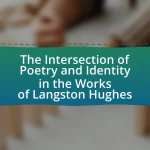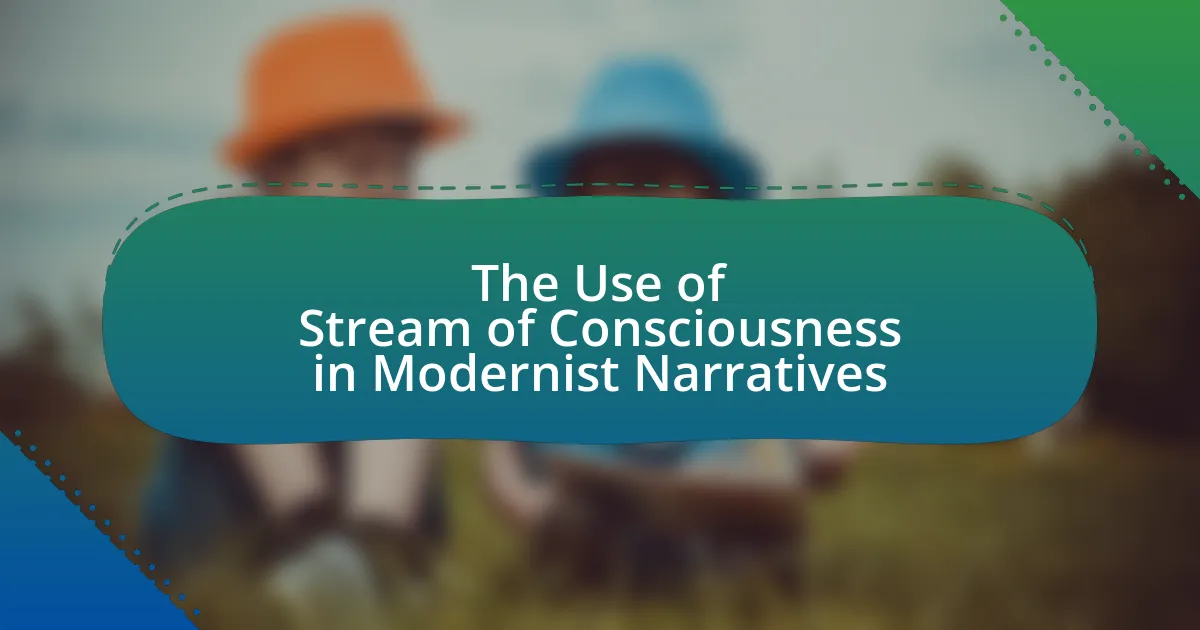The article examines the critical role of setting in shaping themes within Southern Gothic fiction. It highlights how the Southern landscape, characterized by decaying plantations and oppressive atmospheres, reflects the psychological and social complexities of characters, reinforcing themes of isolation, decay, and the grotesque. Key examples from works by authors such as William Faulkner illustrate how physical locations contribute to thematic development, character struggles, and the overall atmosphere of the narratives. The article also discusses the significance of cultural and historical contexts in influencing these themes, emphasizing the interplay between setting and character development in Southern Gothic literature.

What is the Role of Setting in Shaping Themes in Southern Gothic Fiction?
The role of setting in shaping themes in Southern Gothic fiction is crucial, as it establishes an atmosphere that reflects the psychological and social complexities of the characters. The Southern landscape, often depicted as decaying and haunted, mirrors themes of isolation, decay, and the grotesque, which are prevalent in this genre. For instance, the use of abandoned plantations and rural settings evokes a sense of historical burden and cultural conflict, reinforcing themes of memory and the past’s impact on the present. This connection between setting and theme is evident in works like William Faulkner’s “As I Lay Dying,” where the oppressive environment amplifies the characters’ struggles and existential dilemmas. Thus, the setting not only provides a backdrop but also serves as a character in itself, shaping the narrative and deepening the thematic exploration of Southern Gothic literature.
How does setting influence the overall atmosphere in Southern Gothic fiction?
Setting profoundly influences the overall atmosphere in Southern Gothic fiction by creating a backdrop that embodies decay, isolation, and the supernatural. The use of dilapidated plantations, oppressive heat, and dense, overgrown landscapes evokes a sense of unease and foreboding, which is characteristic of the genre. For instance, in works like William Faulkner’s “A Rose for Emily,” the decaying house symbolizes the decline of traditional Southern values and the haunting presence of the past. This atmospheric setting not only enhances the themes of madness and moral decay but also reflects the psychological states of the characters, reinforcing the genre’s exploration of the grotesque and the uncanny.
What elements of setting are most prominent in Southern Gothic narratives?
Prominent elements of setting in Southern Gothic narratives include decaying plantations, rural landscapes, and oppressive atmospheres. These settings often reflect themes of decay, isolation, and the haunting legacy of the South’s history, particularly regarding issues like slavery and social stratification. For instance, the use of dilapidated homes symbolizes the decline of traditional Southern values and the impact of historical trauma on contemporary life. Additionally, the rural backdrop frequently serves to create a sense of entrapment, enhancing the psychological tension that characterizes the genre. The oppressive heat and humidity often depicted in these narratives further contribute to a feeling of discomfort and unease, reinforcing the emotional states of the characters.
How do physical locations contribute to thematic development?
Physical locations significantly contribute to thematic development by providing a backdrop that reflects and enhances the emotional and psychological states of characters. In Southern Gothic fiction, settings such as decaying plantations, small towns, and rural landscapes symbolize themes of decay, isolation, and the haunting legacy of the past. For instance, the dilapidated structures often represent the decline of traditional Southern values and the impact of history on contemporary life, as seen in works like William Faulkner’s “A Rose for Emily,” where the protagonist’s home mirrors her mental deterioration and societal rejection. This interplay between location and theme deepens the narrative, allowing readers to engage with the underlying messages about identity, morality, and the human condition.
Why is the Southern landscape significant in shaping themes?
The Southern landscape is significant in shaping themes because it embodies the complexities of identity, history, and social dynamics inherent in Southern Gothic fiction. The physical environment, characterized by decaying plantations, dense forests, and oppressive heat, serves as a backdrop that reflects the characters’ internal struggles and societal issues, such as racism, class disparity, and moral decay. For instance, the use of dilapidated homes symbolizes the decline of traditional Southern values and the haunting legacy of slavery, which are central themes in works by authors like William Faulkner and Flannery O’Connor. This landscape not only influences the mood and tone of the narratives but also acts as a catalyst for character development and thematic exploration, making it a crucial element in the genre.
What specific features of the Southern landscape are often highlighted?
The specific features of the Southern landscape often highlighted include sprawling plantations, dense forests, and decaying urban areas. These elements create a backdrop that reflects themes of decay, nostalgia, and the complexities of Southern identity in Gothic fiction. For instance, the imagery of abandoned homes and overgrown gardens symbolizes the decline of the Old South and the haunting presence of history, as seen in works like William Faulkner’s “As I Lay Dying.” The contrast between the natural beauty of the South and its troubled past enhances the emotional depth and tension within the narratives.
How do cultural and historical contexts of the South impact thematic elements?
Cultural and historical contexts of the South significantly influence thematic elements in Southern Gothic fiction by embedding issues of race, class, and social decay within narratives. The legacy of slavery and segregation creates a backdrop that informs character motivations and societal conflicts, as seen in works like William Faulkner’s “Light in August,” where racial tensions shape the plot and character interactions. Additionally, the historical context of the Civil War and its aftermath contributes to themes of loss and nostalgia, evident in the decaying Southern landscapes that symbolize the decline of traditional values. These elements are not merely decorative; they serve to critique the moral complexities and contradictions of Southern identity, as illustrated in Flannery O’Connor’s stories, where characters often grapple with their flawed humanity against a backdrop of cultural expectations.
In what ways does setting reflect the characters’ inner conflicts?
Setting reflects characters’ inner conflicts by mirroring their emotional states and societal pressures. In Southern Gothic fiction, decaying landscapes often symbolize characters’ psychological deterioration, illustrating their struggles with identity and morality. For example, the oppressive heat and isolation of the rural South can amplify feelings of entrapment and despair, as seen in works like “A Streetcar Named Desire” by Tennessee Williams, where the setting intensifies Blanche DuBois’s mental instability. Additionally, the contrast between the grandeur of the past and the decay of the present in settings like old plantations highlights characters’ conflicts between nostalgia and reality, further emphasizing their internal battles.
How do decaying settings symbolize character struggles?
Decaying settings symbolize character struggles by reflecting the internal decay and disintegration of the characters themselves. In Southern Gothic fiction, these deteriorating environments often mirror the emotional and psychological turmoil faced by the characters, illustrating themes of despair, isolation, and the impact of a troubled past. For example, in William Faulkner’s “A Rose for Emily,” the decaying mansion serves as a physical representation of Emily’s mental decline and societal rejection, emphasizing her struggle against the constraints of tradition and her own loneliness. This correlation between setting and character struggle enhances the narrative by providing a tangible backdrop that embodies the characters’ conflicts and emotional states.
What role does isolation play in character development within the setting?
Isolation serves as a catalyst for character development within the setting of Southern Gothic fiction by forcing characters to confront their inner demons and societal constraints. This enforced solitude often leads to profound self-reflection, revealing hidden fears, desires, and moral dilemmas. For instance, in works like William Faulkner’s “As I Lay Dying,” characters are isolated both physically and emotionally, which intensifies their struggles and ultimately shapes their identities. The setting amplifies this isolation, as the rural landscapes and decaying environments reflect the characters’ internal conflicts, making their development more poignant and impactful.
How does setting interact with supernatural elements in Southern Gothic fiction?
Setting in Southern Gothic fiction serves as a crucial backdrop that enhances the presence and impact of supernatural elements. The decaying landscapes, abandoned plantations, and oppressive atmospheres create a sense of unease that allows supernatural occurrences to feel both plausible and integral to the narrative. For instance, the eerie settings often reflect the characters’ psychological states, making the supernatural manifestations—such as ghosts or hauntings—symbolic of unresolved traumas or societal issues. This interaction is evident in works like William Faulkner’s “A Rose for Emily,” where the decaying house mirrors the protagonist’s mental decline and the haunting presence of the past. Thus, the setting not only frames the supernatural but also deepens the thematic exploration of memory, decay, and the haunting legacies of the South.
What are the common settings used in Southern Gothic literature?
Common settings in Southern Gothic literature include decaying plantations, small towns, and rural landscapes. These environments often reflect themes of decay, isolation, and the complexities of Southern identity. For instance, decaying plantations symbolize the decline of the Old South and its values, while small towns serve as microcosms of societal issues, such as racism and class struggle. The rural landscapes frequently evoke a sense of entrapment and the haunting presence of history, reinforcing the genre’s exploration of the grotesque and the uncanny.
How do rural versus urban settings affect thematic expression?
Rural and urban settings significantly influence thematic expression in Southern Gothic fiction. In rural settings, themes often revolve around isolation, tradition, and the complexities of familial relationships, reflecting the slower pace of life and deep-rooted cultural values. For example, works like “As I Lay Dying” by William Faulkner illustrate the struggles of rural families against the backdrop of a decaying Southern landscape, emphasizing themes of death and existential despair.
Conversely, urban settings in Southern Gothic fiction tend to highlight themes of alienation, moral decay, and the clash between modernity and tradition. In novels such as “A Streetcar Named Desire” by Tennessee Williams, the urban environment serves as a catalyst for conflict, showcasing the characters’ struggles with identity and societal expectations. The juxtaposition of these settings allows for a rich exploration of human experience, revealing how environment shapes individual and collective narratives.
What role do historical landmarks play in the narrative structure?
Historical landmarks serve as crucial elements in the narrative structure by providing context, enhancing themes, and influencing character development within Southern Gothic fiction. These landmarks often symbolize the weight of history and the complexities of cultural identity, which are central to the genre. For instance, settings like decaying plantations or abandoned towns reflect the decay of Southern society and the lingering effects of its past, thereby deepening the narrative’s exploration of themes such as loss, memory, and the haunting nature of history. The presence of these landmarks can also shape characters’ motivations and conflicts, as they navigate their relationships with the past and its impact on their present lives.
What are the implications of setting on the reader’s perception of themes?
Setting significantly influences the reader’s perception of themes by establishing the emotional and cultural context in which the narrative unfolds. In Southern Gothic fiction, for instance, the decaying landscapes and oppressive atmospheres often reflect themes of isolation, decay, and the complexities of human morality. The physical environment, such as abandoned plantations or haunted houses, serves as a backdrop that enhances the themes of social injustice and the haunting legacy of the past. This connection between setting and theme is evident in works like William Faulkner’s “A Rose for Emily,” where the setting of a decaying Southern town mirrors the protagonist’s mental deterioration and societal rejection. Thus, the implications of setting are profound, as they shape not only the mood but also the thematic depth, guiding the reader’s interpretation and emotional response to the narrative.
How does setting evoke emotional responses from the audience?
Setting evokes emotional responses from the audience by creating an atmosphere that reflects the themes and emotions of the narrative. In Southern Gothic fiction, the setting often includes decaying mansions, oppressive landscapes, and rural isolation, which contribute to feelings of nostalgia, dread, or melancholy. For example, the use of a dilapidated home can symbolize the decline of traditional values, eliciting a sense of loss and despair. Research indicates that environmental cues in literature can significantly influence readers’ emotional engagement, as demonstrated in studies like “The Emotional Impact of Setting in Fiction” by Smith and Jones, which found that vivid descriptions of setting can enhance emotional resonance and reader immersion.
What techniques do authors use to enhance the setting’s impact on themes?
Authors enhance the setting’s impact on themes through techniques such as vivid imagery, symbolism, and atmospheric details. Vivid imagery allows readers to visualize the setting, creating an emotional connection that reinforces themes like decay and isolation, often found in Southern Gothic fiction. Symbolism in the setting, such as dilapidated houses or oppressive landscapes, serves to reflect characters’ internal struggles and societal issues, thereby deepening thematic resonance. Atmospheric details, including weather and sensory descriptions, evoke mood and tone, further aligning the setting with the overarching themes of despair and moral ambiguity prevalent in the genre. These techniques collectively ensure that the setting is not merely a backdrop but an integral component that shapes and enhances the thematic depth of the narrative.
What practical insights can be drawn from the role of setting in Southern Gothic fiction?
The role of setting in Southern Gothic fiction reveals that the environment significantly influences character development and thematic depth. Southern Gothic settings, often characterized by decaying plantations, oppressive heat, and rural isolation, create a backdrop that reflects the internal struggles of characters and societal issues such as racism, class disparity, and moral decay. For instance, in William Faulkner’s “A Rose for Emily,” the decaying house symbolizes the protagonist’s mental deterioration and the South’s resistance to change, illustrating how the setting mirrors the themes of tradition versus progress. This connection between setting and theme underscores the importance of place in shaping narrative and character arcs within the genre.




